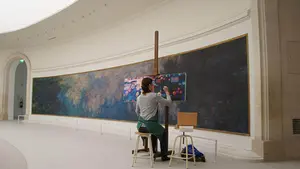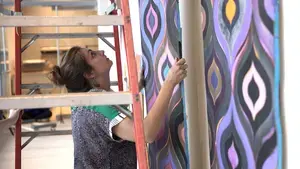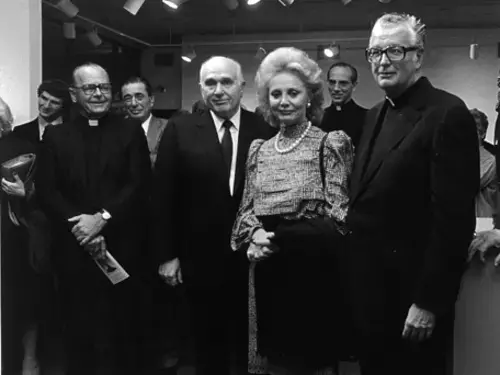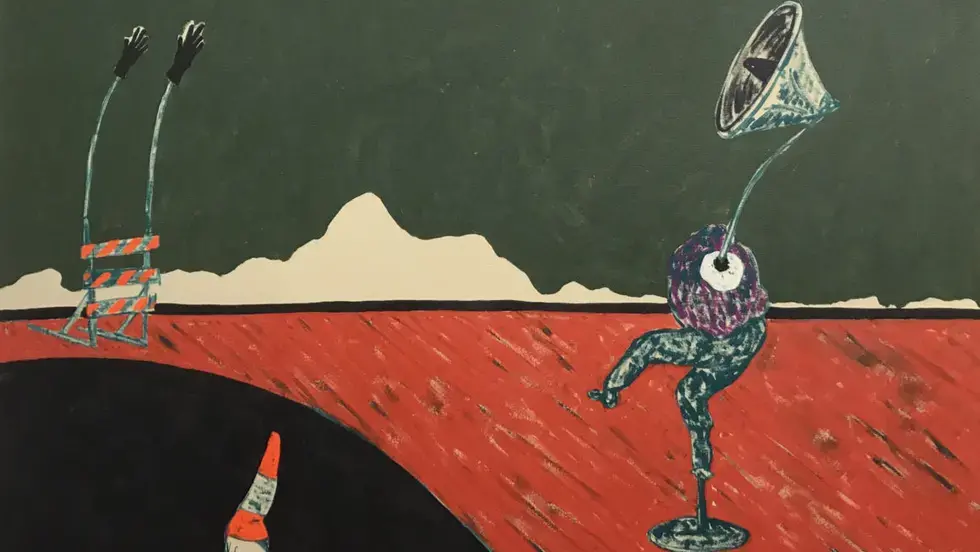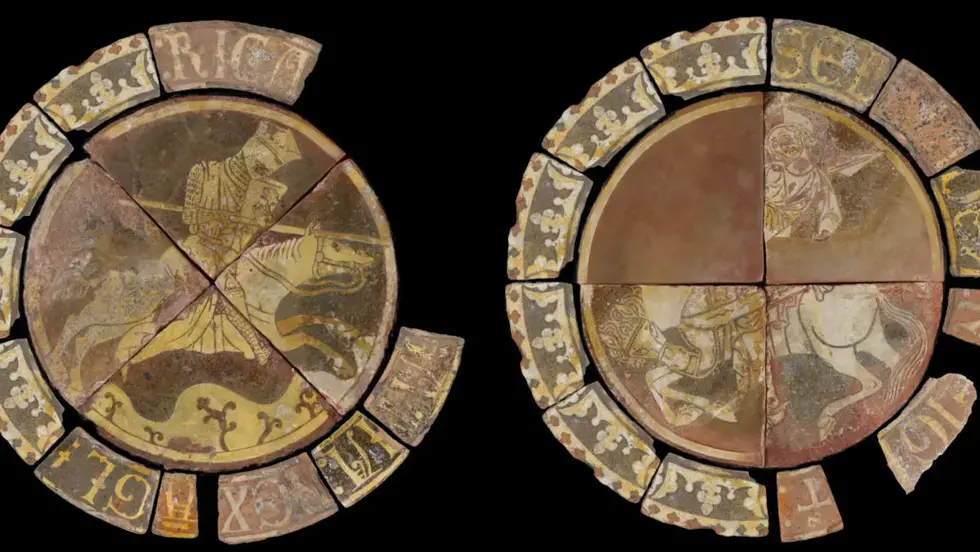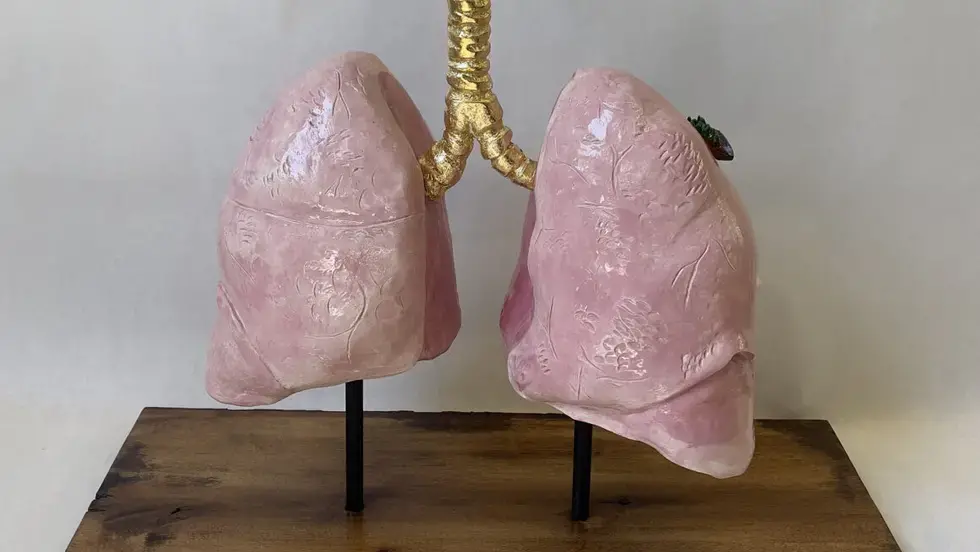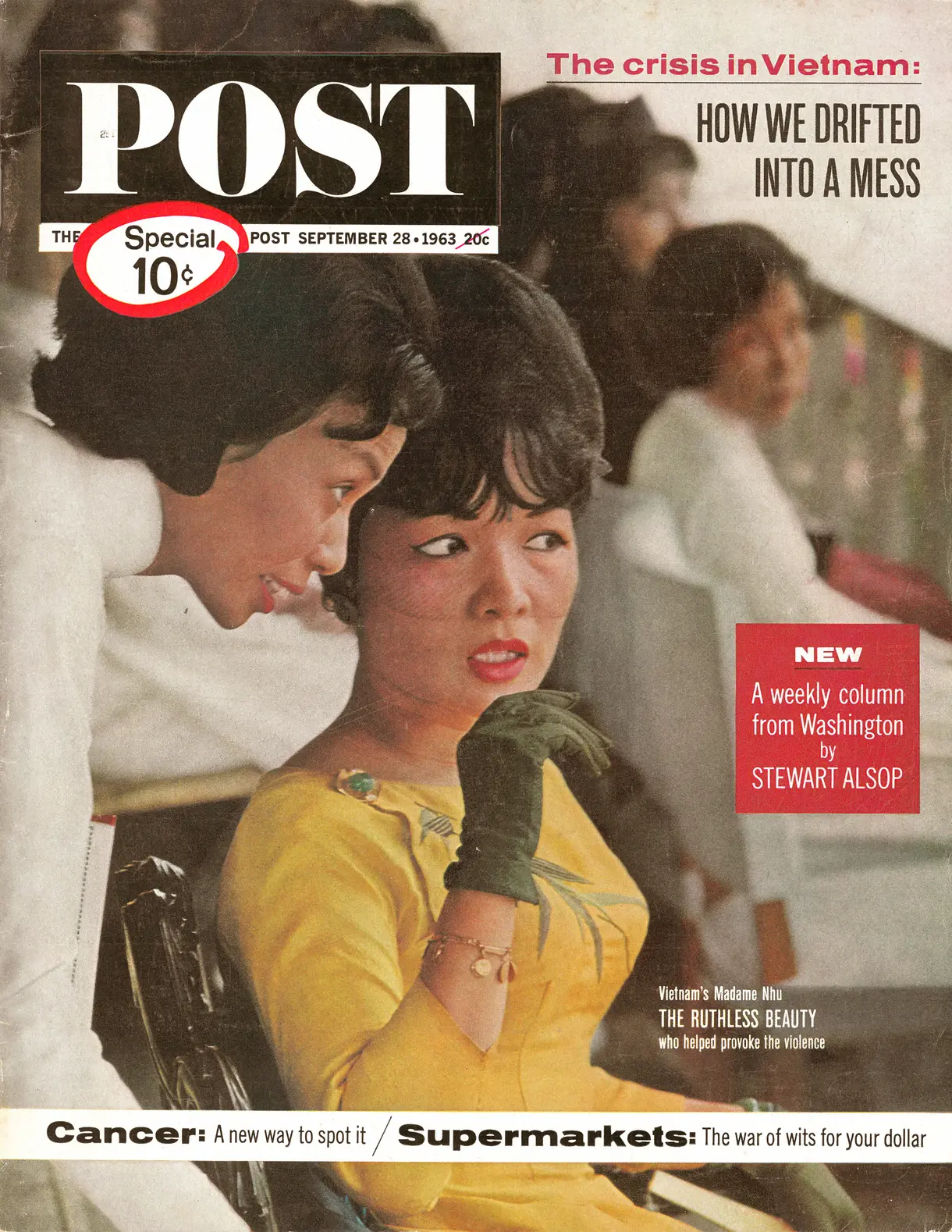
Cantor Art Gallery
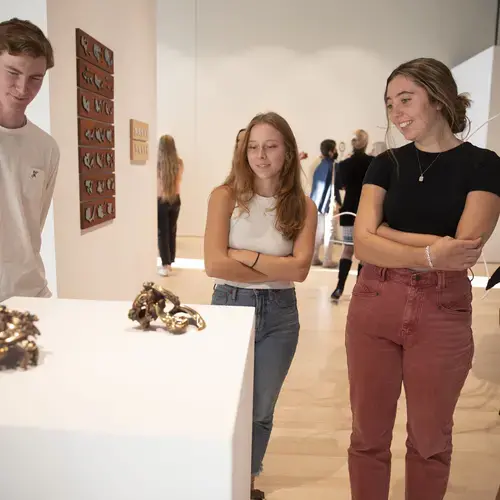
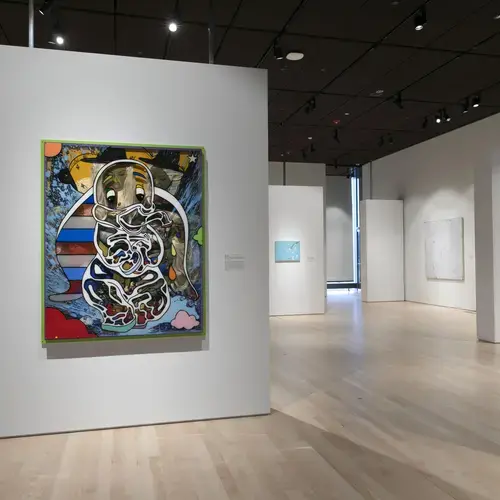
A world-class gallery intersecting with a liberal arts education.
The Iris and B. Gerald Cantor Art Gallery is more than just a space for exhibitions; it’s a place where art and academic life converge to inspire curiosity, reflection and discovery.
Our Mission
The mission of the Iris and B. Gerald Cantor Art Gallery is to promote and support the intellectual and cultural life of College of the Holy Cross. Through its exhibitions and acquisitions, both historical and contemporary, the gallery serves as a catalyst for the search for meaning and value in life and history, and as a venue to stimulate dialogue about questions related to the mission of the College. Exhibitions are selected to not only integrate with our broader liberal arts curriculum, but to educate our audiences on the fundamental intellectual, cultural, spiritual and aesthetic issues encountered through art.
Current Exhibitions
Plan Your Next Visit
The Vietnamese Áo Dài in a Time of War: Fashion, Citizenship, and Nationalism (1954–1975)
August 26-December 19, 2025
The Vietnamese Áo Dài in a Time of War explores the significance of Vietnam’s national costume—the áo dài—during the Vietnam War. Honoring the 50th anniversary of a conflict, the legacies of which continue to haunt us to this day, the exhibition highlights the contributions of Vietnamese women to politics, society, and culture. Artifacts trace the history of the áo dài as a practical item of clothing and important symbol of Vietnamese heritage and identity in Vietnam, among Vietnamese Americans, and on the global stage—thus showing how a national costume can be both traditional and modern fashion with meanings that change over time and space. Co-curated by Professors Ann Marie Leshkowich (Anthropology, College of the Holy Cross), Martina Nguyen (History, Baruch College, City University of New York), and Tuong Vu (Political Science, University of Oregon).
(The Saturday Evening Post cover photo by Burt Glinn © SEPS licensed by Curtis Licensing Indianapolis, IN.)
Events

Opening
Sept. 11, 4:30 p.m. | Rehm Library (Smith Hall)
Fashion, Politics, and Cultural Identity: The Vietnamese Áo Dài
A panel discussion about the role of Vietnam’s national costume—the áo dài—in individual and national expression across Vietnam and the Vietnamese diaspora. With co-curators Prof. Ann Marie Leshkowich, Prof. Martina Thucnhi Nguyen (Baruch College), and Prof. Tuong Vu (University of Oregon), along with fashion designers Si Hoang and Thai Nguyen.
Reception
Sept. 11, 6 p.m. | Cantor Art Gallery (Prior Performing Arts Center)
Featuring Vietnamese appetizers and cash bar.
Film Screening: Journey from the Fall
Sept. 12, 5 p.m. | Rehm Library (Smith Hall)
Vietnamese American actress Kieu Chinh speaks with fashion designer Thai Nguyen about her trajectory as an actress and her work in the public eye on notable projects such as HBO’s miniseries The Sympathizer and the 1993 film The Joy Luck Club. The conversation is followed by a screening of the drama Journey from the Fall (2006), which traces the struggles of one family after the Fall of Saigon in 1975.
Living Threads: Community, Culture and the Áo Dài
Oct. 23, 4 p.m. | Cantor Art Gallery and Beehive (Prior Performing Arts Center)
4-4:30 p.m. | Guided tours in the Cantor Art Gallery
4:30-6 p.m. | Community art-making event led by artist, community organizer, and Holy Cross alumnus John Vo; Polaroid station; and Vietnamese food
Presented in collaboration with the Division of Justice, Equity, Belonging and Identity; A.S.I.A.; and Holy Cross EMBODY Fashion Club.
Concert: The Odyssey–from Vietnam to America
Nov. 4, 7:30 p.m. | Luth Concert Hall (Prior Performing Arts Center)
Marking the 50th anniversary of the end of the Vietnam War, The Odyssey–from Vietnam to America explores the personal and spiritual journeys of the Vietnamese refugees known as “Boat People.”
The Odyssey musically contextualizes them in larger terms of human struggle for survival in the face of conflict and political upheaval. The work, created by composer-performer Vân-Ánh Vanessa Võ in partnership with Yerba Buena Center for Performing Arts (YBCA), Creative Work Fund (CWF), and Asia Society Texas Center (ASTC), combines Vietnamese instruments, electronic sounds and Western instruments. Vietnamese folk songs, especially lullabies, are a key compositional element.
Vân-Ánh Vanessa Võ and the Blood Moon Orchestra perform with the Arneis Quartet in a special performance at the College of the Holy Cross.
All events are free and open to the public.
Christine Sun Kim (b. 1980, active Berlin, Germany), Mind Touch Touch Touch, 2025, digital print of charcoal drawing
Repetition and iteration define Christine Sun Kim’s work, which distinctly incorporates the visual representation of sign language. This mural was made exclusively for the Cantor’s front window and comes from a body of work that combines text and graphic representations of signs in American Sign Language (ASL). Here, Kim depicts the arc of the hand movement in the sign obsess, which is a compound formed by the signs for mind and touch. Through her practice, Kim foregrounds Deaf culture; explores the relationship between sound, language, and image; and explores the social politics of communication. CLICK HERE for a video of obsess being signed in ASL.
Christine Sun Kim joins the 2025-26 Prior Presents Visiting Artist Series in a February 19 co-presentation with the Holy Cross Department of Visual Arts.
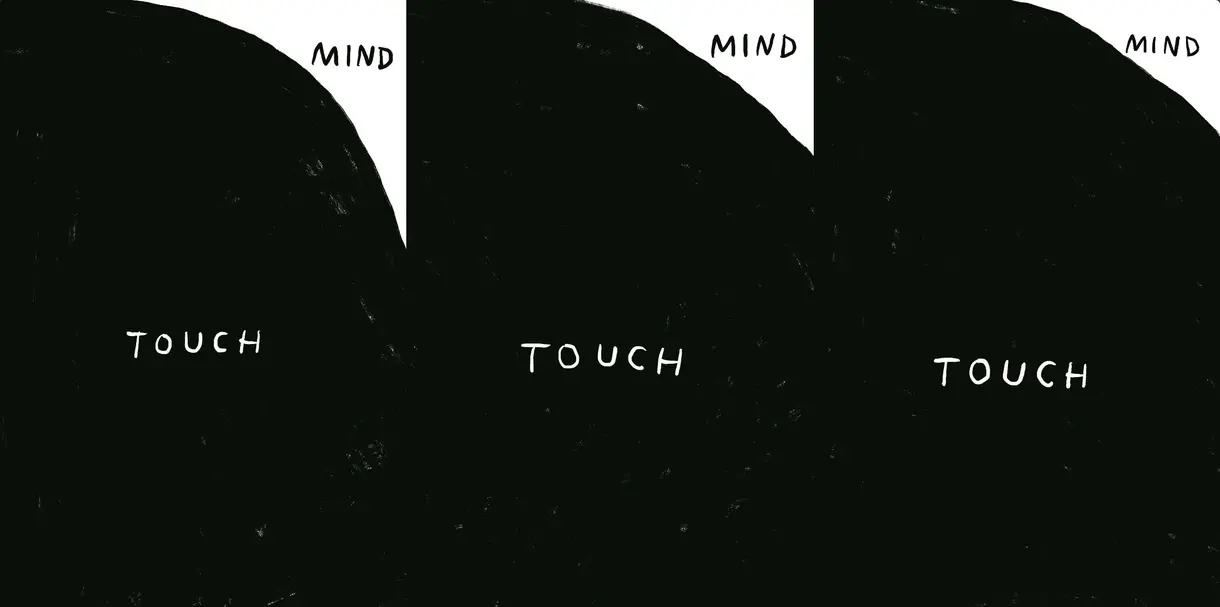
(Image courtesy of the artist, François Ghebaly, Los Angeles and New York, and WHITE SPACE, Beijing.)
Permanent Collection
The Iris and B. Cantor Art Gallery has more than 1,000 objects in its permanent collection. Through the generosity of alumni, artists and friends of the College, the gallery has become a resource to the campus community for permanent and rotating placements of art objects that enhance the landscaped grounds of the campus and interiors of many academic buildings. A rotating selection of the permanent collection is often on view in the Iris & B. Gerald Cantor Foundation Resource Gallery adjacent to the main gallery space.
The permanent collection represents a broad spectrum of art and historical periods and is enriched by the gift of a teaching collection comprised of historical Southeast Asian textiles from West Sumatra, and other islands of Indonesia, India and Laos.
A recent major gift of drawings from the archive of American abstract expressionist Robert Beauchamp (1923-1995) was given to the College by his widow Nadine Valenti Beauchamp, with an exhibition curated by Professor Maurice Géracht (English), Professor Leslie Schomp (Visual arts) and the director of the Cantor, Roger Hankins, which was on view from January 25 through March 28, 2018.
Additional notable works in the permanent collection include sculpture by Auguste Rodin, Enzo Plazzotta, Chaim Gross, Peter Grippe, Georg Kolbe, Robert Beauchamp and Robert Wlerick; photographs by Marilyn Bridges, Paul Caponigro, William Garnett, Eliot Porter and Dorothy Norman; and paintings, prints and drawings by Michael Beatty, Robert Beauchamp, François Bonvin, Robert Goodnough, Terri Priest, Dorothea Rockburne, James Stroud and John Wilson.
Previous Exhibitions
At Holy Cross, art is woven into the fabric of student life. Exhibitions are carefully selected to complement our academic programs, sparking new perspectives and conversations that continue beyond the gallery walls.
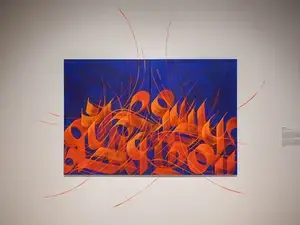
"Ritual and Devotion" is Sneha Shrestha's first major solo exhibition which explores the concepts of ritual and devotion beyond the sacred to include the secular.
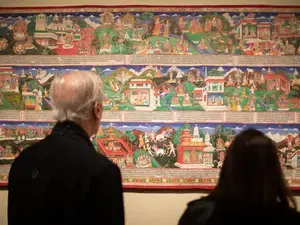
“Dharma and Punya: Buddhist Ritual Art of Nepal” displays nearly one hundred objects of Buddhist ritual art, many rarely seen in the West.

The work of graduating senior visual arts studio majors showcase their work in "Fine Art: Senior Concentration Seminar Exhibition" from April 26 - May 25, 2018.
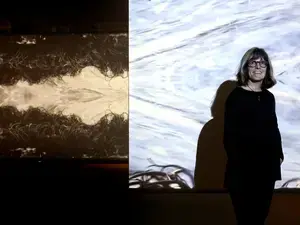
An immersive and visually complex exhibition, “Club Disminución” draws upon Horochowski’s versatility as an artist, as she mixes a range of media to create a vibrant installation environment.

From the exhibition “Gabrielle Thierry: The Musicality of the Water Lilies/La Musicalité des Nymphéas” that ran from Aug. 30 through Oct. 7, 2017. Thierry’s series of eight large-scale paintings were inspired by her rediscovery of the “Water Lilies” landscapes by Claude Monet on view at the the Musée de l’Orangerie in Paris.

“In Process: Contemporary Photographers Rethinking Their Medium From the Collection of Mark D. Nevins ‘86” presents the work of 22 contemporary photographers who are exploring the medium and technologies of photography in a diversity of ways.
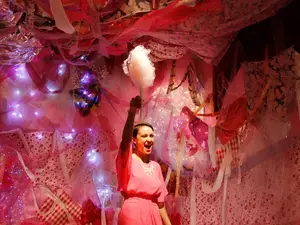
Graduating visual arts students who have participated in the year-long Senior Concentration Seminar present their work in “Amalgam” from April 28 - May 27, 2016.
Digital Archives
Our History
Location and Hours
We are located on the third floor of The Prior Performing Arts Center. Admission is free and open to the public.
The Cantor Art Gallery will be closed for the College's winter break from Saturday, December 20 through Monday, February 2. Please visit us when we reopen on February 3, 2026!
Standard Hours
Monday: by appointment only
Tuesday: 10 a.m.-5 p.m.
Wednesday: 10 a.m.-5 p.m.
Thursday: 10 a.m.-6 p.m.
Friday: 10 a.m.-5 p.m.
Saturday: 12 p.m.-5 p.m.
Sunday: closed
Iris and B. Gerald Cantor Art Gallery
Prior Performing Arts Center
1 College Street
Worcester, MA 01610
Subscribe to our Newsletter
Sign up to receive gallery news and events information.
